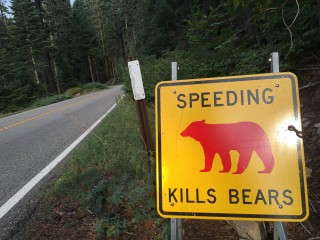Traffic violence in America knows no boundaries.
Even in our national parks, which are set aside as sanctuaries for wildlife, road authorities are forced to address this issue. In Yosemite National Park, where I spent eight days earlier this month on a family vacation, the National Parks Service estimates that over a dozen black bears are killed each year after as a result of park visitors who run into them with their cars. In 2010, the NPS reported 28 “vehicle-bear collisions.”
To “increase visitor awareness of the high frequency of vehicle-animal collisions” and encourage people to drive more carefully, the NPS started an awareness campaign in 2007. It consists of roadside signs and posters throughout the park that feature a red bear and the simple phrase, “Speeding Kills Bears.” The signs are placed in locations where the animals have been hit. They’re like ghost bikes for bears.
The campaign is hard to miss. In addition to the signs, the related paraphernalia is sold in the park’s markets, online store and gift shops. I saw this poster at a gas station…
It’s even available as a fridge magnet…
And my wife and kids could tell I was so intrigued with the concept they bought me a coffee mug…
Advertisement
It’s a powerful message. After all, who doesn’t love bears? To hit one while on vacation — especially in a place where you go specifically to observe them in their natural environment — would be terrible. And the campaign seems to work. If I ever started driving a bit too fast (the speed limit in the park is 35 mph) I would be immediately called out by my kids. Even my four-year-old would yell from the back seat, “Dad! Speeding kills bears!”
When we saw a mama and her cubs ramble across the road ourselves, the message really sunk in.
Of course my mind wandered to how a campaign like this might translate over to humans in cities. In my experience, road agencies are reluctant to do anything that puts 100 percent of the onus of saving lives on those doing the driving. Yosemite’s campaign seems to work, not just because of its simple and powerful message, but because of the assumed innocence of the victim. It’s free from the baggage of debate about who’s at fault because the victim is immedidately respected, loved and considered completely innocent by all parties.
Does this mean in order for this to work with humans we’d have to create that same social dynamic with all victims of traffic violence — whether they walk on four legs or two? I hope not. Because that’s not likely to happen (just look at the continued media coverage of the “distracted pedestrian” phenomenon for example).
How do we create the same type of sympathy that makes people slow down for bears translate into a concern for fellow humans? Are there some lessons here we can use in our own traffic safety efforts? Do you think a “Speeding Kills Humans” campaign would work on our streets?







